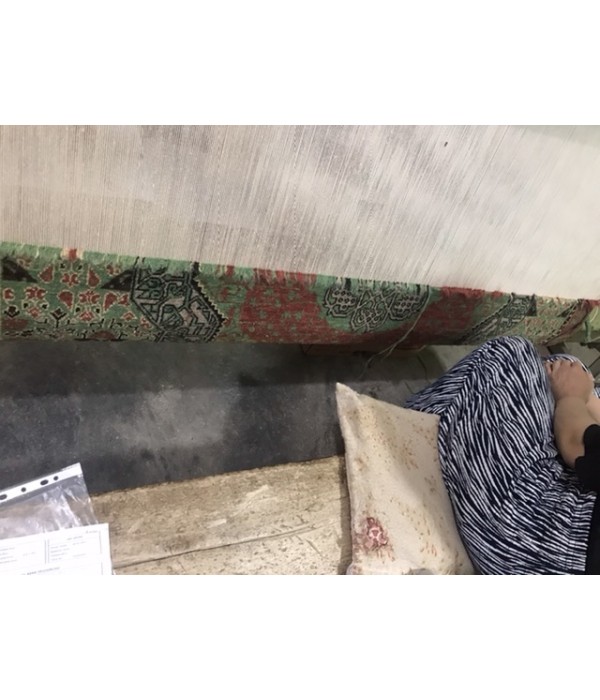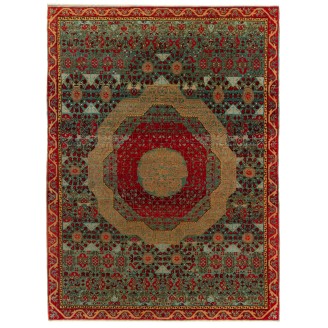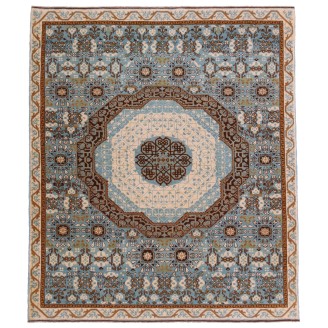Mamluk Rug with Cusped Medallion
















Model: ART00390Mamluk Rug with Cusped Medallion
Group: Islamic Rugs Family
Area: Mamluk
Material of Pile: Natural Dyed Hand-spun Wool
Material Warp / Weft: Wool on Wool
Structure: Symmetrical knot
Knots Density: 39x39
Pile (mm): 2
Production Place: Southeastern Anatolia – Diyarbakir - Derviş Hasan
Weight: 10.80kg
Location: Tokyo
Stock: In Stock
Dimensions:
The design source of the rug comes from The C. L. David Collection, Copenhagen. This rug with the Cusped Medallion was designed in the early 16th-century rug by Mamluk Sultane of Cairo, Egypt. Once in the Hirth Collection, and later with Ulrich Schürmann in 1965, this piece now belongs to the David Collection, Copenhagen. It is like the Berlin "Lagerfeld" piece, its medallion rests on a field strewn with para-Mamluk elements. Many of the most elegant Mamluk carpets employ the cusped, or scalloped medallion form. It perhaps arrived in Egypt from the Turkmen areas controlled by the Ak-Koyunlu, and later the Safavids; or it may have traveled East from Egypt. The elements characteristic of the para-Mamluk group are chiefly found on carpets with large roundels; two exceptions are the Eskenazi carpet, and the Unger Endre, which is a category of its own. The forms were probably created for the Hapsburg 3-medallion carpet in the MAK Vienna, which exhibits them in their most perfect form.Attempting to read early carpets produced in workshops in Cairo provides an entirely different set of challenges. Cairene carpets, distinguished by their limited color palette, symmetrical knotting, and unusual construction of S-spun wool (Z-spun wool being the norm almost everywhere in the Islamic world), underwent a sudden change in design sometime after the Ottoman Turks conquered the Mamluk empire in 1517. The Simonetti Carpet was probably woven after the conquest but exhibits the “old” fifteenth-century style of the Mamluks. Long and narrow, it was woven on a standard-sized Egyptian roller-beam loom, capable of producing carpets of varying lengths. It consists of five major focal areas of design in an A-B-C-B-A pattern, meaning the first and fifth and the second and fourth areas are paired, while the middle is unique. We can easily term these five focal areas medallions, but they are geometric in both layout and detail, and their style (as opposed to the actual date of the weaving) predates the carpet design revolution that gave rise to the medallion format. We can surmise that the designs and colors of Mamluk carpets, with their unusual combination of insect-derived red, blue, green, and sometimes yellow, with virtually no undyed white at all, constitute an effort to create a recognizable brand in the early modern market, especially in Europe, where Mamluk carpets such as this, with their subtle coloration, incredibly detailed design, and mosaic-like layout of small and intricately patterned geometric motifs, constituted an appealing alternative to the more coarsely woven and brightly colored carpets from Anatolia, such as Ushak medallion carpets. While the weaving of carpets in the traditional geometric Mamluk designs apparently continued well into the seventeenth century, sometime around the mid-sixteenth century, Cairene weavers began to create an entirely new kind of carpet, using their traditional Mamluk materials, technique, and coloration but reflecting the latest styles then being created at the court of the Ottoman sultans in Istanbul. Our designers interpret the design of the rug, and soft colors are chosen for this rug.
Color summary: 7 colors in total, most used 4 colors are
Color summary: 7 colors in total, most used 4 colors are
- Mix Green
- Salmon 536 (Madder Root)
- Dark Brown 316 (No Dye - Sheep’s own Color)
- Bamboo Beige 99 (Natural Sheep's Color)
Dimensions:
4 ft 11 in x 6 ft 5 in ( 152cm x 197cm )
Price:
$5,100
Ex Tax: $5,100










